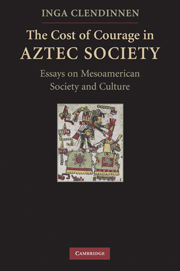1 - The Cost of Courage in Aztec Society
Published online by Cambridge University Press: 05 August 2012
Summary
Proud of itself
is the city of Mexico-Tenochtitlán.
Here no one fears to die in war.
This is our glory …
Who could conquer Tenochtitlán?
Who could shake the foundation of heaven?
Today we are tempted to read this fragment of an Aztec song-poem as a familiar piece of bombast: the aggressive military empire which insists on its invincibility, its warriors strangers to fear. In what follows I want to indicate how the business of war was understood in the great city of Tenochtitlán, and then, in more but still inadequate detail, to enquire into how warrior action was sustained and explained, in the hope of drawing closer to an Aztec reading of this small text.
That Tenochtitlán was the creation of war and the courage and stamina of its young fighting men was indisputable. The splendid city which Cortes and his men saw shimmering above its lake waters in the autumn of 1519 had been founded as a miserable collection of mud huts less than two hundred years before. Some time late in the twelfth century the final abandonment of the once-great imperial city of Tula to the north had begun a restless movement of peoples southwards, to the gentler lands of the valley of Mexico. By the close of the thirteenth century more than fifty “miniscule polities” jostled in the valley, bound together by trade and increasingly, as population and ambition grew, by the determination to exact tribute from each other.
- Type
- Chapter
- Information
- The Cost of Courage in Aztec SocietyEssays on Mesoamerican Society and Culture, pp. 6 - 48Publisher: Cambridge University PressPrint publication year: 2010



